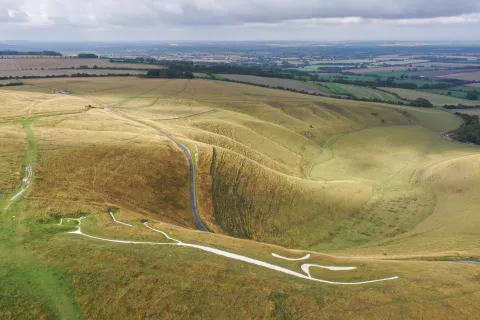The preservation of the Uffington White Horse owes much to the dedication of the local communities. Since the 18th century, their commitment has taken shape through organized efforts known as scourings, ensuring the continued care of this remarkable monument.
In 1738, Wise appealed to the Nobility and Gentry to adopt the White Horse scouring as the ‘Saxon Olympicks’. From 1776 – 1812, there are accounts of these events in local newspapers every four or five years. As well as cleaning -or "scouring" the Horse thousands of people gathered on the Hill from far and wide to watch the sporting events: from horse racing to a pipe-smoking competition for women.
As the Industrial Revolution brought a new age and movement of people towards the cities, far-reaching changes were afoot in society. Change and unrest in the coal-soaked towns of the north were matched by the enclosure of common land in the countryside, disrupting communities and traditions. Opposition to change was not taken kindly by the local gentry and magistrates, who were now not so keen to mix with the "troublesome peasantry" at community events. At White Horse Hill, the scouring events faded into memory.
By 1857 the organised scouring had lapsed for fourteen years. A group of men gathered in Uffington, led by Edwin Martin-Atkins and Thomas Hughes (the author of a new best-seller Tom Brown’s Schooldays). Hughes was a Christian Socialist, a writer and a boxing coach. He believed in improving the lot of the workers, and hope to heal the wounds in society by resurrecting the ancient scouring, with its sporting activities. The Chairman, Martin-Atkins, was a competent archaeologist, who carried out excavations on White Horse Hill. He invited the secretary of the Society of Antiquaries, John Younge Akerman, to join their group. Akerman strongly opposed the ‘Alfred’ interpretation of the Horse, believing the Iron Age coin evidence indicated its origin.
Thomas Hughes’ novel The Scouring of the White Horse provides us with a description of the 1857 event, its huge crowds, frantic cheese-rolling race down the Manger and the backstaff fighting.
So Who Should look after the White Horse?
The 1857 event was a success, but the last of its kind. As England urbanised rural sports were no longer in fashion. Instead football, horse-racing, music halls and sea-side resorts attracted the crowds. Academics also won the dating argument. King Alfred remained enormously popular in Imperial Britain, but a pagan prehistoric Horse became increasingly less attractive to the patriotic population.
Scheduled Ancient Monuments
After years of effort and opposition proponents of ancient monument protection (Sir John Lubbock and George Shaw-Lefevre) finally succeeded. The Ancient Monuments Protection Act became law in 1882. Attached to the Act was a Schedule of 68 sites in England, 21 in Scotland, 18 in Ireland and 3 in Wales. These included Wayland’s Smithy and Uffington castle. But not the White Horse – probably because of the dating dispute.
The White Horse itself was finally protected on 13 December 1929, probably because, three years before, the celebrated archaeologist Sir Flinders Petrie had surveyed the Horse and declared it to be Bronze Age in date (not very convincingly).
In this period the Horse had been neglected, though in 1892 Lady Craven paid £10 for a dozen men to clean it. It was unclear who if anyone had the responsibility to maintain it. The Daily Mail in 1922 bemoaned its neglect. Travellers on the train across the Vale complained: "something needs to be done about it".
The authorities evidently listened because in the first aerial photographs taken in the 1930s we see the White Horse in good shape. Then in 1940 it was covered over to hide the landmark from the Luftwaffe.
Today White Horse Hill is legally protected for its ancient monuments, as a Site of Special Scientific Interest and as an Area of Outstanding Natural Beauty. It is the responsibility of English Heritage and Nature England, while the land is managed by the owners, the National Trust.


